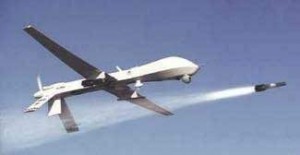Drones at War: An Introduction to the Law and Debate of “Targeted Killing”
 Thank you to Dean O’Hear for inviting me to write this month as the alumni blogger.
Thank you to Dean O’Hear for inviting me to write this month as the alumni blogger.
For the past few weeks, public attention has focused on the President’s decisions regarding the lethal targeting of known terrorists and other non-state hostile actors. Although the issue may be relatively new to the public, it has long been a source of debate among legal experts in the area of international humanitarian law – also known as the Law of Armed Conflict or LOAC – and international human rights law (IHRL). The debate largely centers on what is called “Targeted Killing.” The intent of this post is not to discuss the legality of Targeted Killing itself, but to instead point readers to detailed sources to help readers start studying the Targeted Killing debate or the Law of Armed Conflict more generally.
Without exception, anyone interested in the subject must certainly start by reading the Targeted Killings case from Israel in 2005. Beyond the Targeted Killings case, there is a growing body of treatment by scholars such as Kenneth Anderson, Laurie Blank, Amos Guiora, Nils Melzer, Mary Ellen O’Connell, and many, many more – far too many to list exhaustively. One method may be to read one, and then follow up by reading the sources they cite or refute. The United Nations released a study on the phenomenon as well, available here.
The question of Targeted Killing presents a number of pressing issues in the area of LOAC and IHRL, especially highlighting the tension between them.

